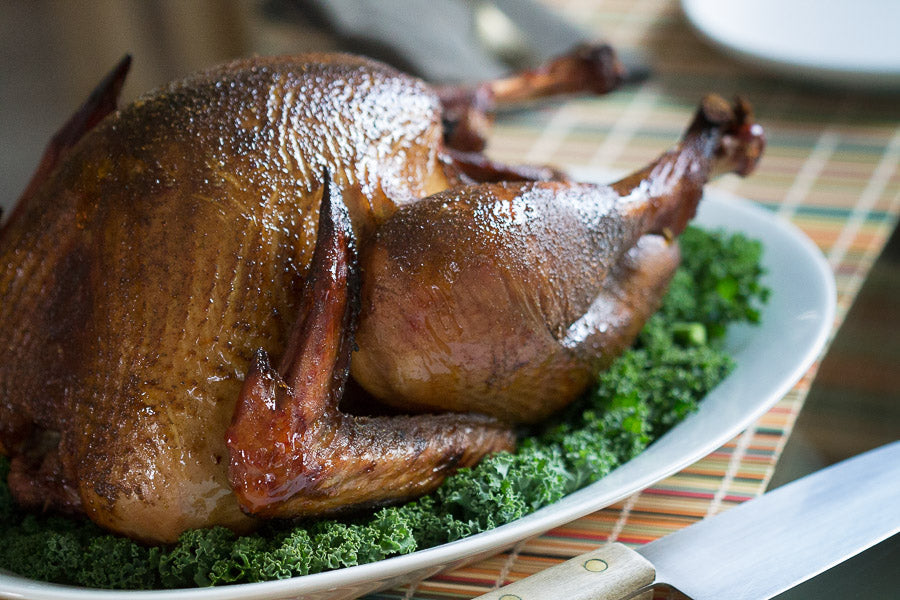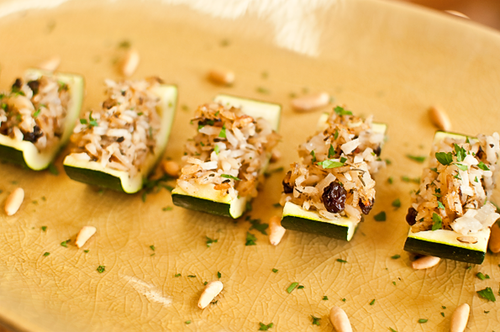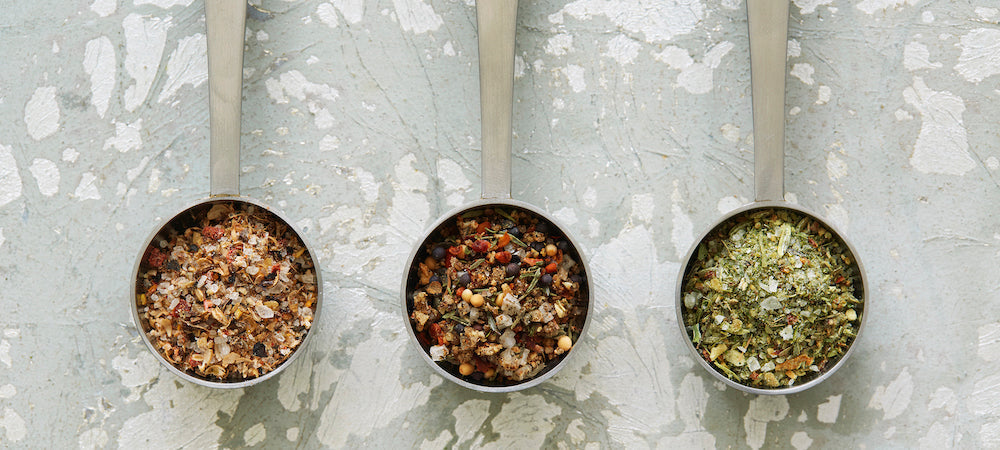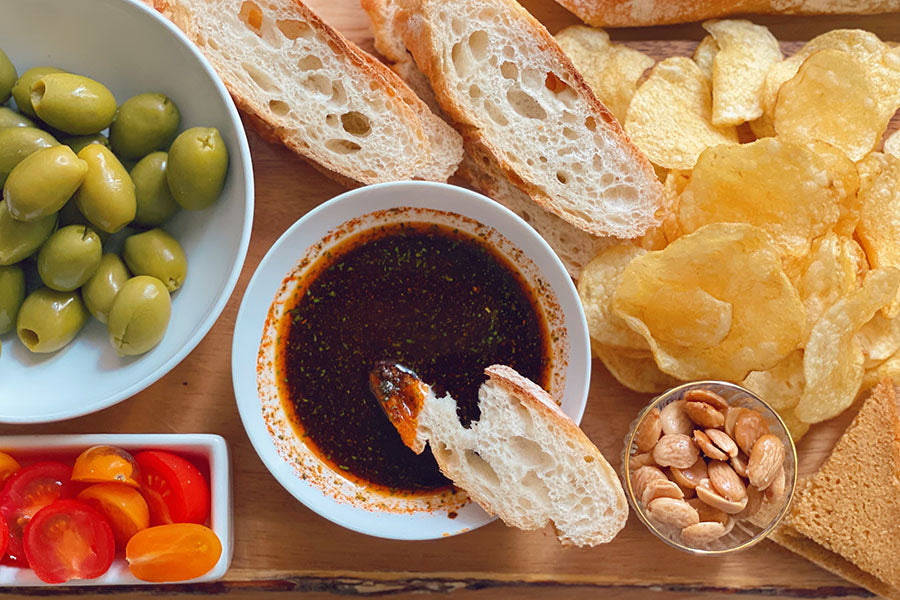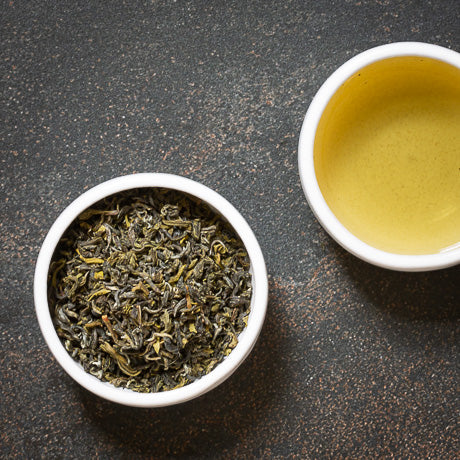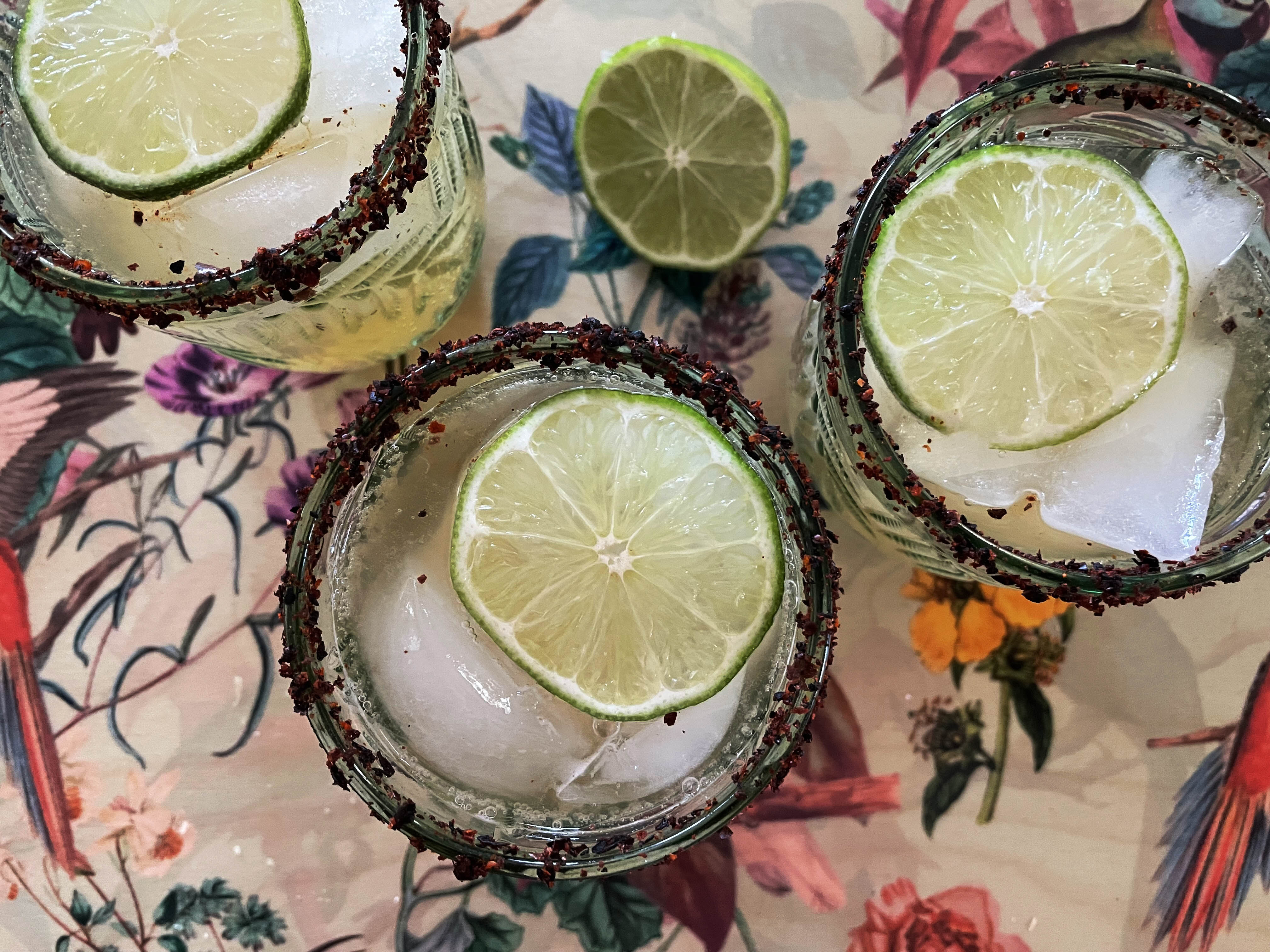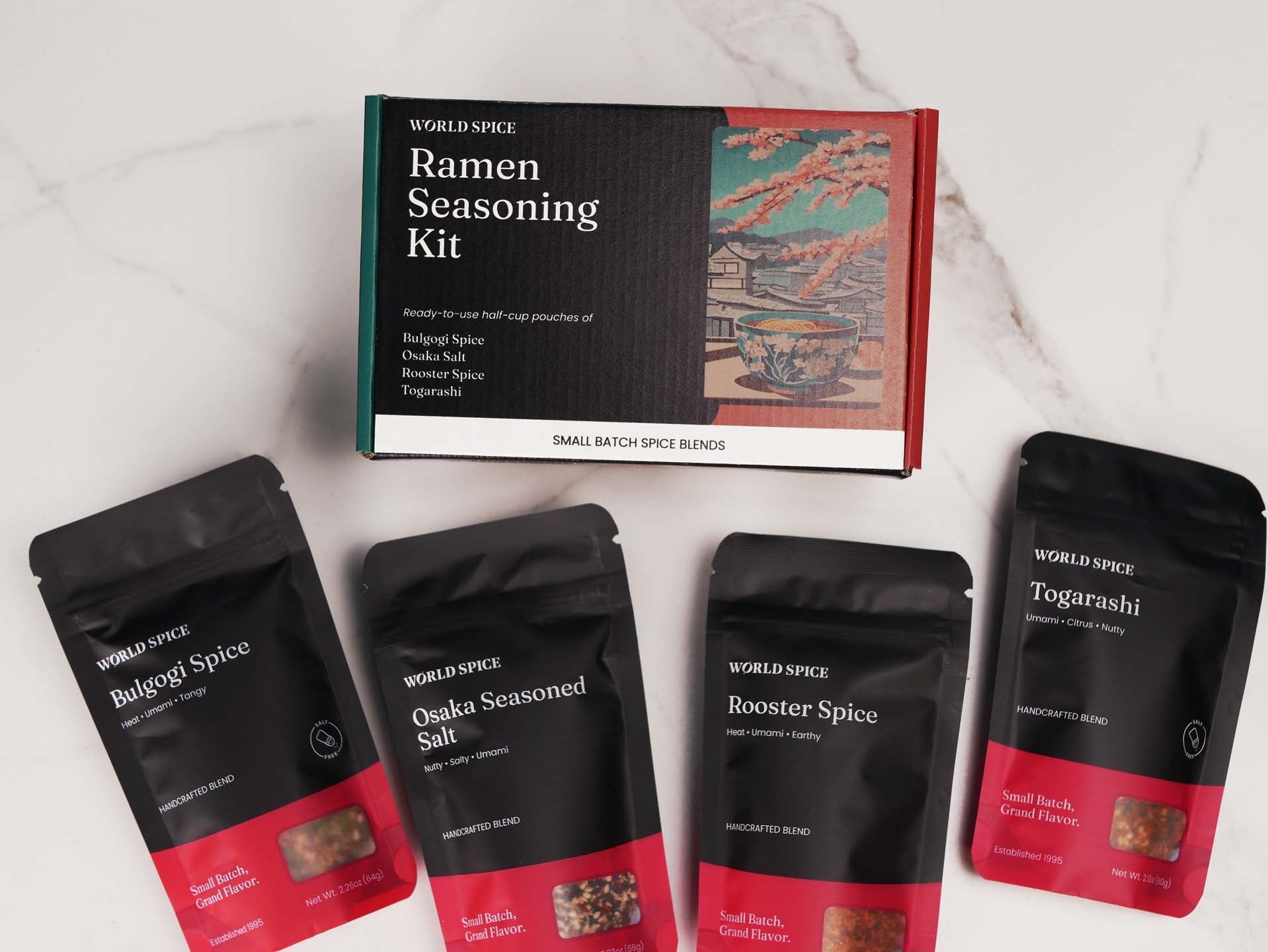Cooking Guides & Tips
Thanksgiving Turkey Rubs and Brines
Thanksgiving might be weeks away, but your turkey deserves some early love. Choosing the right spices now isn’t just smart — it’s strategic.The right blend can turn a good bird into a great one, and planning ahead means you’ll actually have time to relax and enjoy the big day. Whether you’re a traditionalist, a flavor explorer, or somewhere in between, here are the spices that’ll make for an unforgettable turkey. Poultry Rub This classic blend is built on a robust foundation of Sage, Thyme, Marjoram, and Rosemary, with refreshing touches of Black Pepper, Garlic, Onion, and Celery. The best choice for familiar flavors with a fresh, vibrant twist. Northwest Forest Brine Northwest Forest Brine leads with Juniper, imparting distinctive pine and citrus notes, beautifully complemented by Fennel, Green Pepper, and Allspice. Designed to be used as a wet or dry brine, it infuses rich, aromatic flavor into your bird. Fin & Feather BBQ Rub Make your turkey the talk of the table with Fin & Feather. It balances classic barbecue rub flavors (Paprika, Black Pepper, and Garlic) with traditional poultry spices (Onion, Lemon Peel, Sage, and Marjoram). Ras El Hanout Craving something unexpected? Ras El Hanout is just the ticket. This 24-ingredient blend layers your turkey with fragrant warmth, bold spice, and a touch of sweetness, creating a bird that’s rich, complex, and totally unique. Turkey Tips: Spice With Confidence Plan Ahead: Rub your turkey with spices a few hours before roasting — or better yet, the night before — so the flavors really sink in. Early prep = stress-free holiday. Get Under the Skin: Gently lift the skin over the breast and rub in some seasoning. That’s where the magic happens. Don’t Skimp: And go for even coverage — legs, cavity, wings — a little love everywhere ensures every bite sings. Keep It Dry: Pat the bird dry before rubbing. Moisture is the enemy of crispy, flavorful skin. Sneak a Taste: Cooking a turkey is serious business, but sampling a tiny nibble of seasoned meat while it cooks? Totally allowed. Consider it quality control. Curious about brining? Stay tuned — next week, we’ll talk more about brines. Shop our collection of rubs and brines.
Learn moreHow to Use Up All That Zucchini
Happy "National Sneak Some Zucchini Onto Your Neighbor’s Porch" Day! It’s officially peak zucchini season. For home gardeners, it’s both a blessing and a struggle — the bumper crop can quickly take over your yard, fridge, kitchen counter … your entire life. And when coworkers start avoiding eye contact as you arrive with a tote bag, take the hint: they, too, have hit maximum squash saturation. You can stick with the porch-sneaking tradition, or follow our lead. Here’s how we’re happily eating our way through the surplus. El Greco Zucchini Cheddar Muffins A perfect make-ahead breakfast for busy mornings or lazy weekends alike. Zucchini keeps them tender and moist, while our El Greco blend adds a bold, herby punch that plays perfectly with the cheddar. Get the recipe. Kofte Spice Stuffed Zucchini Make it a snack, make it a side — just make it. This Turkish-inspired dish looks impressive but comes together easily, thanks to our Kofte Spice. The mix of peppermint and savory adds a refreshing twist for warm summer days. Get the recipe. Summer Vegetable Pasta Bake For summer gatherings, this veggie-packed pasta bake is an easy way to feed a crowd — and make quick use of all that zucchini alongside the burgers and brats. Try it with our Fines Herbes or Tuscan Rosemary Salt. Get the recipe.
Learn moreSeasoning Salts for Everything & Anything
These aren’t your average grocery store blends. Our handcrafted Seasoning Salts are made in small batches using ultra-fresh ingredients you can actually pronounce. Plus, like everything at World Spice, they're all filler-free! Think bold flavor, not mystery dust. Svaneti Seasoned Salt This Georgian blend is a shopkeeper's favorite and our go-to for roasted veggies and meat of all kinds. Garlic Salt Packed with nine fresh ingredients and serious flavor cred, it’s what our resident herbalist Aubrey calls “the most herbaceous and bodacious Garlic Salt out there.” Tuscan Rosemary Salt Designed to transport your kitchen to the rustic, Italian countryside. Rosemary brings the charm, while ginger and cinnamon add a delightfully unexpected touch. Osaka Seasoned Salt Perhaps the unsung hero of our collection, this Japanese-inspired blend ticks all the flavor boxes — salty, savory, crunchy, bright. It’s a best friend to noodles, seafood, eggs, and braised leafy greens. Provencal Seasoned Salt Classic French flavors without the intimidation factor. Balanced herbs, aromatics, citrus, and tomato make this all-in-one seasoning a major timesaver — no mise en place required. Voodoo There are two types of people in this world: those who love Voodoo, and those who haven’t tried it yet. It's our best-selling blend for a reason. America's Seasoned Salt This blend is pure Americana — we’re talking the roadside diner with the jukebox at the table, shiny red booths, and a waitress who calls you “honey.” Shop all Seasoning Salts
Learn moreHow to Use Sumac
Before lemons became a kitchen staple, there was Sumac. And lately, it's having a moment. Easy Does It: Quick and Foolproof Ways to Enjoy Sumac SPRINKLE it over store-bought or homemade hummus to add the perfect pucker. TOP avocado toast with Sumac and flaky sea salt. Tart Sumac complements the creamy avocado, and the color combination is lovely. Remember — you eat with your eyes first! MIX with thinly sliced cucumbers and red onions, mint leaves, olive oil, salt, and pepper for a fresh Levantine-style summer salad. Tell Me More This deep red spice comes from the dried berries of the Sumac shrub, native to the Middle East and parts of the Mediterranean, and it’s been used for thousands of years to add bright, tangy flavor to everything from grilled meats to rice dishes and dips. Ground Sumac has a flavor that falls somewhere between lemon zest and hibiscus — tart, fruity, and just a little earthy. It’s a dry spice that behaves like acid, making it a clever substitute when you’re out of lemons or don’t want to add extra liquid to a dish. Use it anywhere you’d reach for citrus to brighten things up — no juicer required. If you're in the mood for something sweet ... Try This: Sumac Strawberry Pound Cake
Learn moreBerbere and Tomatoes — Summer's Power Couple
There’s a moment in every summer that gardeners know well: the one where you realize — again — that maybe five tomato plants was a bit ambitious. Our secret weapon? Berbere. This Ethiopian and Eritrean spice blend is traditionally used to season wats — thick, deeply spiced stews of chicken, beef, or lentils. In our kitchens, we’ve found that Berbere is best friends with tomatoes. It shines in chili, tomato sauces, soups, and even sprinkled over fresh tomato salads. So whether you’re a canner, a freezer, or a fresh-everything type, Berbere just might be your secret summer savior. Easy Does It: Quick and Foolproof Ways to Enjoy Berbere MIX a teaspoon into half a cup of ketchup for hot and spicy dipping. SWAP out Berbere for the usual Italian herbs in your next batch of tomato sauce. ADD a tablespoon of Berbere per pound of ground beef, mix well, form into patties, and fire up the grill. Try This: Berbere Sheet Pan Tomatoes Preheat oven to 400°F. Toss 1 pound halved vine tomatoes and 1 cup thinly sliced onion with 2 tablespoons olive oil, 2 teaspoons Berbere, and 1 1/2 teaspoons Pacific Flake Sea Salt. Spread on a parchment-lined sheet pan, cut side up. Roast for 25 minutes until tender and caramelized. Serve warm.
Learn moreMeet Kana & Enjoy 20% Off Their Line of Sustainable Cookware
To kick off summer entertaining season, we teamed up with our friends at Kana — makers of beautiful, sustainable kitchenware like Dutch ovens, cast iron skillets, and baking pans — to share one of our favorite ways to host: a relaxed, seasonal brunch at home. Kana's offering World Spice customers 20% off their entire site with code WSPICE20 — making now the perfect time to upgrade your kitchen gear or pick up a thoughtful gift for your favorite host. So what’s cookin’? A gorgeous Lemon and Thyme Rhubarb Cake, baked to perfection and served alongside our mellow Keemun black tea. Simple, shareable, and seriously good. Crowd Pleaser Bright, tender, and topped with jewel-toned rhubarb, this cake is a stunner — whether it’s the finishing touch or one of many bites on the table, don’t be surprised if everyone asks for the recipe (and there aren’t any leftovers). Get the recipe. Tools of the Trade We baked ours in Kana’s 9-inch Stainless Steel Cake Pan — sleek, durable, and made from 100% recycled materials — and lined it with their genius Easy-Lift Parchment Rounds. No sticking. No stress. No crumbs left behind. And that handsome cutting board pictured above? It’s reversible — one side has a smooth surface with juice grooves, and the flip side doubles as a serving tray or charcuterie board. Even better, it’s handcrafted by Kana from reclaimed North American wood. Beverage Service A slice of this cake practically begs for a pot of Keemun — a mellow Chinese black tea with notes of cocoa, stone fruits, and smoke. Smooth and rich, it brings balance to the tart rhubarb and herbaceous Thyme.
Learn moreSpice-11: Spice age, green tea bitterness, and garlic
Got a kitchen conundrum? You ask, we answer! Send your query to spiceadvice@worldspice.com and our Culinary Committee will get back to you as soon as they can. And who knows — you might even see your question featured in a future edition of Spice-11! 📬 How old is too old for spices? Not like Y2K old — more like Obama’s-first term old. Asking for a friend. Sounds like it might be time to refresh your spice pantry. Give those old jars a sniff — chances are they don’t smell like much. And if they don’t smell like anything, they won’t taste like anything either. The nose knows! Spices don’t “go bad” in a way that will make you sick, but they do lose their punch and complex flavors over time. For peak flavor, we recommend using your spices within a year of purchase. 📬 My green tea is always bitter! I use loose-leaf (because, duh, I know better) and steep the leaves in boiling water. I love the green tea my local barista makes — it’s smooth and delicate — but when I try to make it at home, it tastes harsh. What gives? A lot of people struggle with this, so you're not alone! The trick to brewing a delicious cup of green tea is hot — but not boiling — water. Boiling water scalds the leaves, causing that bitter taste that gives green tea a bad rap. Turns out it’s just misunderstood. To brew a teashop-worthy cup of green tea, heat your water to 165°F - 170°F and steep for three to four minutes (over-steeping can also make tea bitter). Pro Tip: No fancy kettle with a temperature gauge? No problem! Use a cooking thermometer — or bring the water to a boil, take it off the heat, and let it sit for about eight minutes. 📬 Help! I think I live with a vampire — or maybe they just can't eat garlic. What should I do?! While we can't vouch for its vampire-fighting abilities, Asafoetida is an incredible garlic substitute that delivers allium flavor without the alliums. Use a pinch anywhere you'd typically use garlic.
Learn moreCooking with Tea
How to Cook with Tea There’s nothing like a hot cup of tea to make the world feel a little brighter. We love sipping our favorite brews, of course — but tea has way more to offer than just comfort in a cup. Turns out, it’s a secret weapon in the kitchen, too. From baked goods to grains to glazes, tea brings unique depth and subtle aroma to your cooking. Here are a few easy (and delicious) ways to start experimenting. Add Depth to your Favorite Dishes The easiest way to use tea in cooking is to brew a batch and use it in place of plain water. This works great for cooking rice, grains or small pasta like couscous and orzo. The grains soak up the tea's flavor — try Darjeeling, Kukicha, or Chrysanthemum Flowers for an unexpected flavor twist. Brewed tea can also replace the water used for steaming veggies and fish, or in our flour tortilla recipe. Steeped in Flavor Roast chicken recipe featuring our Asian Tea Rub. Tea makes for a bold addition to rubs and marinades. We love using Lapsang Souchong for both because of the strong smoky flavor it brings. For rubs, grind a portion of your chosen tea and add a few teaspoons to your favorite rub recipe (or use our Asian Tea Rub for a ready-made solution). For marinades, brew a strong cup and add a splash to your other liquid ingredients. Sweeten the Deal Our recipe for Sumac strawberries with pound cake featuring our Jasmine Pearl Tea. And trust us, tea is especially well-suited for sweets. Bring a whole new dimension to your Sunday pancakes and infuse loose tea into maple syrup — just heat it over low heat for 10–15 minutes, strain, and enjoy. Try infusing tea leaves in cream to make custard — like in our Irish Breakfast Butter Pudding. You can also use brewed tea for our versatile Tea Glaze or grind the leaves to mix directly into baked goods like our Jasmine Pearl Pound Cake. And for a quick and deliciously aromatic upgrade, grind tea leaves or flowers (Elderflower and Roses are especially beautiful!) with white or brown sugar to garnish cookies, cakes, and other baked goods.
Learn moreTalk Spicy to Me: In Conversation With Our Spice Oracle
Sherrie dishes on baking & how a boxed dessert became a beloved, better-for-you date bar Happy World Baking Day! To celebrate, we sat down with our very own Spice Oracle, Sherrie Hahn, to talk about her love of baking — and her legendary date bar recipe. Her treats are a regular delight for our Seattle team, and we’re so excited to share them with you. Before joining World Spice (over 20 years ago!) Sherrie received her formal culinary education from the Seattle Art Institute, and worked in the kitchens of several excellent restaurants throughout Seattle including Andaluca, Fish Club, Cactus, and Gitano. Sherrie brings something truly special to our small business. Not only is she incredibly generous with her treats, but also with her knowledge — so if you’re in Seattle, be sure to stop by and say hello. Without further ado, here’s the story behind the bars (and the baker) that keep our crew smiling. How did you first get into baking? Sherrie: My mom would always bake on the weekends, whether from a box mix or from scratch. Some were family recipes, some were from magazines — she didn’t have a lot of cookbooks. I remember, as a kid, sitting in front of the oven door watching pita pockets rise — that was a Sunset Magazine recipe she made often. Cookies, cakes, bread, pies, fudge, or Grandma’s divinity recipe during the holidays.What inspires your baking today?Sherrie: I have a lot of cookbooks (don’t ask how many!) and follow a lot of food bloggers, chefs, and authors. The history lover in me is drawn to old-school, classic recipes — they’re cool, and some are even making a comeback. I love being creative in the kitchen, whether it’s the blending of cultures or cuisines to come up with something new and delicious or using an everyday ingredient in a new way.What's the story behind your legendary date bars? Sherrie: My mom used to make it from a mix — I can’t remember if it was Betty Crocker, Duncan Hines, or Pillsbury. Maybe it just seemed “healthier” than chocolate something-or-other, but it was always a favorite in our household. The mix was discontinued years ago. When I moved back to Seattle after college (shoutout to Boston University!), I had a temp job. Someone brought in date bars they’d made, and they tasted just like the mix! They gave me the recipe and I found it again years later and finally made it. It was just as good as I remembered, but sooooo sweet. Dates are plenty sweet on their own, and most recipes add way too much sugar, so I set about making it a little healthier. The original recipe only called for cinnamon, but Advieh felt like the perfect upgrade — especially knowing how loved dates are in Persian cooking.What makes this recipe special to you?Sherrie: It’s super easy to make, uses Advieh — one of my favorite spice blends — and can be easily adapted to be gluten-free for my gluten-free friends. Plus, it satisfies my sweet tooth without too much guilt. And of course, the senses of smell and taste definitely trigger memories. I often tell folks in the shop to trust their noses — your nose remembers what you like to eat better than your brain does! Have you made any changes to the original recipe over the years? Sherrie: Sometimes I substitute coconut oil for the butter in the dough, and I’ve subbed rye, spelt, gluten-free, or wheat flour for the all-purpose flour. I’ve also used various oat blends — my favorite is one from Trader Joe’s that has gluten-free oats, amaranth flakes, quinoa flakes, chia seeds, and ground flax seeds. It’s an easy way to sneak more nutrition into something sweet. Life’s too short to eat boring food, you know?Any tips you can share? Sherrie: I find that using parchment paper or foil to line the pan makes it easier to remove the date bars so they can be cut. If you don't have Advieh, you could absolutely use just cinnamon — they’d still be delicious.Do you have a favorite tea to pair with the date bars? Sherrie: Obviously, Onyx Rose — my favorite black tea blend. Toasted Kukicha would be fabulous, too. And for herbal options, Honeybush, Floral Sonnets, or Ginger Sunrise would all be great choices. Get the recipe. Try It, You'll Like It Advieh, the secret ingredient in Sherrie's Date Bars, is a mix of sweet Cinnamon, Cardamom Seed, and Roses, which are grounded by the earthiness of Cumin and Black Pepper, and finished with a bright pop of Indian Coriander.
Learn more

